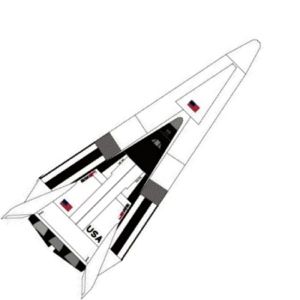
Home - Search - Browse - Alphabetic Index: 0- 1- 2- 3- 4- 5- 6- 7- 8- 9
A- B- C- D- E- F- G- H- I- J- K- L- M- N- O- P- Q- R- S- T- U- V- W- X- Y- Z
Starclipper
 Starclipper Credit: © Thomas Kladiva - Thomas Kladiva |
AKA: Starlifter. Status: Study 1966. Payload: 22,700 kg (50,000 lb). Thrust: 22,840.00 kN (5,134,630 lbf). Gross mass: 1,600,000 kg (3,500,000 lb). Height: 56.90 m (186.60 ft). Diameter: 32.30 m (105.90 ft). Span: 50.00 m (164.00 ft). Apogee: 555 km (344 mi).
Lockheed's "Starclipper" was designed under the supervision of one of the company's senior designer, Max Hunter, in 1966. The spacecraft was an elaboration of the USAF Flight Dynamics Laboratory's ILRV concept. The LSC-8MX spaceplane was 56.9 m long and had a 32.3 m wingspan. During ascent toward orbit liquid hydrogen fuel was drawn from two 7.22 m diameter drop tanks that were arranged along the leading edge of the sharply swept re-entry vehicle. A variable geometry wing deployed after re-entry to provide additional lift for subsonic cruise and landing. The high fineness lifting body vehicle's shape was based on the FDL-5LD and FDL-8H shapes developed at FDL through 1967.
The Starclipper had a gross lift-off mass of 1.6 million kg, and could carry 22,700 kg to orbit in its 6.7 x 18 m payload bay. Five engines provided 2.33 million kg of thrust at lift-off (in the publicly revealed alternative configuration). The propulsion configuration, classified until the 1990's, used a linear aerospike engine. The external tanks were jettisoned at 97.5 km altitude and 21,800 kph velocity, then splashed down in the ocean 4000 km downrange. The re-entry vehicle had a hypersonic L/D of 1.8, while the swing-wings gave it a subsonic L/D of 8.1 and allowed it to land at 290 kph. It was equipped with an air-breathing engine to allow go-arounds and missed approaches during the airfield landing. Lockheed used this configuration as the starting point for its Space Shuttle studies in 1968-71.
LEO Payload: 22,700 kg (50,000 lb) to a 555 km orbit at 55.00 degrees. Flyaway Unit Cost 1985$: 28.000 million.
Stage Data - Starclipper
- Stage 0. 1 x Starlifter Tank. Gross Mass: 257,778 kg (568,303 lb). Empty Mass: 12,971 kg (28,596 lb). Isp: 455 sec. Burn time: 209 sec. Isp(sl): 355 sec. Diameter: 8.00 m (26.20 ft). Span: 8.00 m (26.20 ft). Length: 25.00 m (82.00 ft). Propellants: Lox/LH2. No Engines: 0. Engine: None. Status: Study 1968.
- Stage 1. 1 x Starlifter. Gross Mass: 42,630 kg (93,980 lb). Empty Mass: 19,955 kg (43,993 lb). Thrust (vac): 5,217.000 kN (1,172,828 lbf). Isp: 455 sec. Burn time: 228 sec. Isp(sl): 355 sec. Diameter: 15.85 m (52.00 ft). Span: 15.85 m (52.00 ft). Length: 25.00 m (82.00 ft). Propellants: Lox/LH2. No Engines: 3. Engine: SSME. Status: Study 1968.
Family: orbital launch vehicle, Winged. Country: USA. Stages: Starlifter, Starlifter Tank. Agency: Lockheed. Bibliography: 44.
Back to top of page
Home - Search - Browse - Alphabetic Index: 0- 1- 2- 3- 4- 5- 6- 7- 8- 9
A- B- C- D- E- F- G- H- I- J- K- L- M- N- O- P- Q- R- S- T- U- V- W- X- Y- Z
© 1997-2019 Mark Wade - Contact
© / Conditions for Use